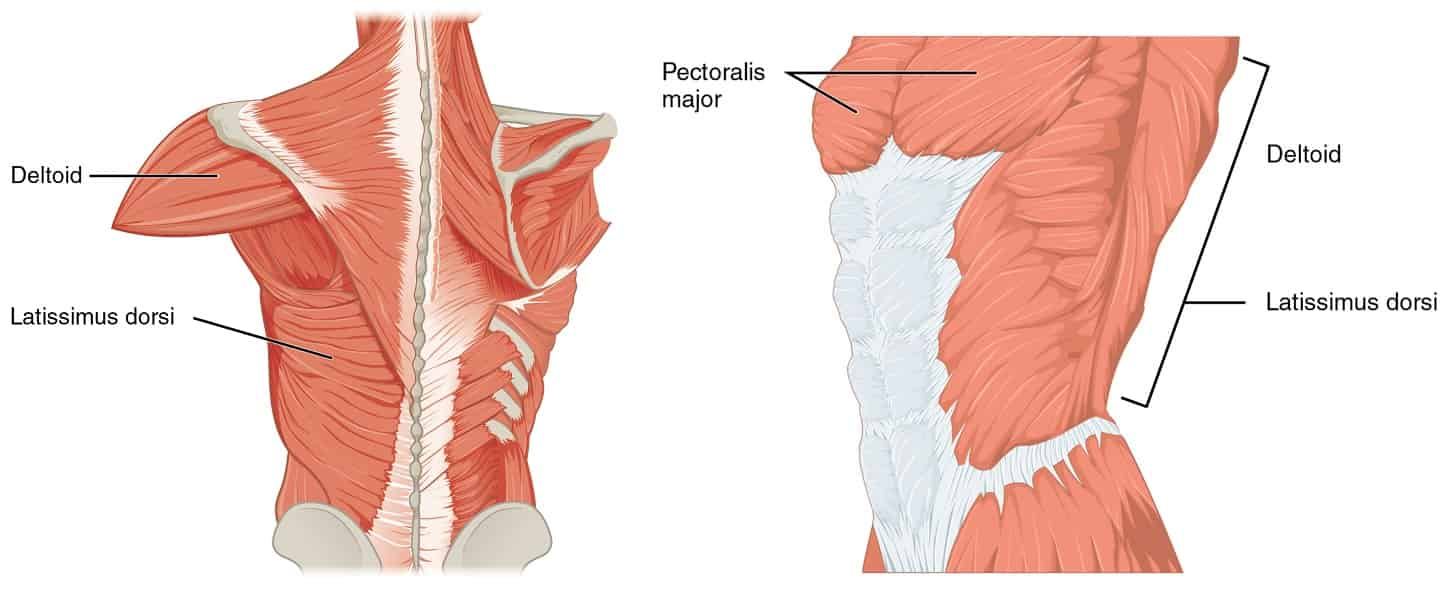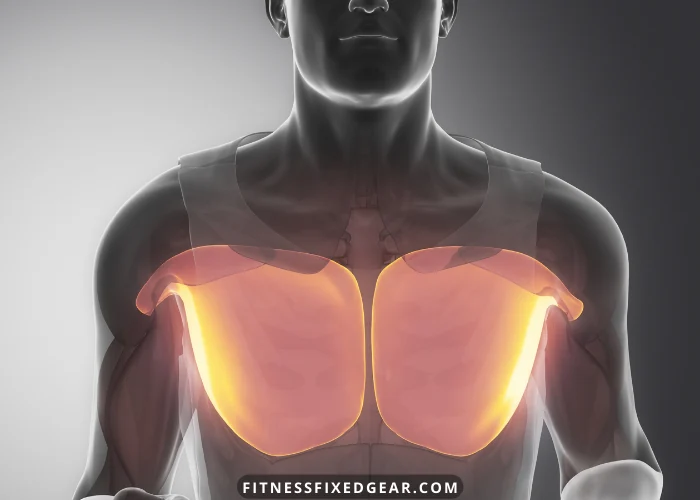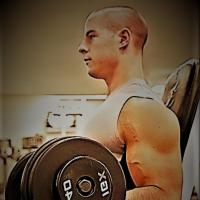Straight arm pulldowns are a stellar exercise to build a jacked back. They're straightforward and an isolation movement, meaning you really target your latissimus dorsi (more on the exact muscle groups targeted later) while keeping the majority of the rest of your body out of the movement.
But what if you don't have access to a cable machine? Or what if you simply don't like pulldowns?
We've got you covered — welcome to your definitive straight arm pulldown alternative list.
- Bent Arm Dumbbell Pullovers
- Dumbbell Seal Rows
- Dumbbell Pullovers
- Dumbbell Renegade Rows
- High Cable Rows
- Barbell Rows
- T-Bar Rows
- Inverted Rows
- Close-Grip Pull-Ups
- Lat Pulldowns
Let's go.
What Is a Straight Arm Pulldown?
A straight arm pulldown is, well, exactly like it sounds — it's a move that has your arms straight and you pulling a weight down toward your hips. Here's the how-to:
- Set the machine to your desired weight. Grasp the handles with hands wider than shoulder width. Step back until your arms are completely outstretched and then bend forward at the waist, so your back is at approximately a 30º angle at the waist. This is your starting position.
- Tighten your lats and keep a gentle bend in your elbows but straight arms. Exhale as you contract your lats to pull the bar down until your hands are beside your thighs.
- Inhale to slowly — with control — return the bar to the starting position.
TL;DR: Straight arm pulldowns use a cable machine and a pulling motion to work your back muscles.
Straight Arm Pulldown – Muscles Worked
What muscle groups do straight arm pulldowns work? Mostly, they target your latissimus dorsi, or your lats.
These large muscles begin at your shoulder blades, curve slightly around your core, and end just above your lower back.

So if you want that coveted jacked, V-shaped back or want to improve your pull up game, straight arm pulldowns can help.
Supporting muscles:

- Pectoralis major (chest muscles)
- Lower and middle trapezius (upper back)
- Biceps brachii (arm muscles)
- Infraspinatus (shoulder blade muscles)
- Flexors of the wrist and hand
- Abdominals
TL;DR: While straight arm pulldowns generally zero in on your lats, they're also stellar full upper body exercises.
What Makes a Great Straight Arm Pulldown Alternative?
Simply put, a great straight arm pulldown alternative will work all the same muscle groups as a lat pulldown. It will largely target your lats while also giving your chest and the rest of your upper body some attention.
Straight arm pulldowns are sometimes also called lat pulldowns.
Still, there is one slight difference: straight arm pulldowns are generally done standing, with your upper body forward, whereas lat pulldowns are usually done seated, with your torso upright (more on lat pulldowns at the end of the list of exercises).
Otherwise, consider these straight arm pulldown alternatives as great lat pulldown alternatives.
TL;DR: An effective straight arm pulldown alternative will work the same muscles as a straight arm or lat pulldown.
The 10 Best Straight Arm Pulldown Alternatives
Without further ado, let's dig into our 10 best straight arm pulldown alternatives.
1. Bent Arm Dumbbell Pullovers
This move is effective because it's accessible to anyone with a single dumbbell and somewhere flat to lay down. No fancy equipment needed.
Equipment Needed:
How To:
- Lie back on a flat bench. Hold the dumbbell above your chest, with your hands circling the handle or holding each end of the dumbbell. Keep your arms slightly-more-than bent and feet firmly planted.
- Inhale as you slowly lower the weight behind your head, keeping that bend in your elbows. Exhale as you slowly return the weight to starting position.
Pro Tip:
To target your lats, the key with this type of dumbbell pullover is to slightly bend and flare out your elbows. If you keep your arms straight, you'll target more of your chest muscles.
2. Dumbbell Seal Rows
Dumbbells are an extremely versatile piece of equipment. If you don't have room for a pile of them, I recommend getting an adjustable set.
For dumbbell seal rows, you're doing a similar movement as an incline dumbbell row, except instead of an incline, you're lying flat.
Equipment Needed:
How To:
- Set your incline bench to completely flat at a height from the ground where you can reach the dumbbells, but you still have a full range of motion.
- Lie face down on the bench with your neck in a neutral position, chin gently on the bench. You can grab the dumbbells from the ground or lay down while holding them.
- Begin with arms extended. Exhale as you row the dumbbells toward the lower part of your ribs, really squeezing your shoulder blades together to activate your lat muscles. Inhale as you slowly lower the dumbbells back toward the ground and the front of your chest.
Pro Tip:
To enhance your mind-muscle connection and target those lats, think more about lifting with your elbows than your hands.
3. Dumbbell Pullovers
We talked about bent arm dumbbell pullovers, but now it's time to talk about a regular dumbbell pullover.
Of course, a dumbbell pullover works more of your chest muscles, but that's okay — a lat pulldown does, too, so it's still a good alternative.
https://www.amazon.com/dp/B001ARYU58?&linkCode=ll1&tag=exercise-articles-20&linkId=ae07e8cd3a63d4714e35a03046f86d13&language=en_US&ref_=as_li_ss_tlhttps://www.amazon.com/dp/B07DNYSJ8W?&linkCode=ll1&tag=exercise-articles-20&linkId=8735ae6a98abb27ec7f384d94f078c83&language=en_US&ref_=as_li_ss_tlEquipment Needed:
- Dumbbell
- Flat bench
How To:
- Follow all the same steps as the bent arm version. Except don't bend your elbows excessively — keep just the slightest bend.
- Extend over your head until you feel a gentle stretch through your chest.
Pro Tip:
To really make a dumbbell pullover work for you, don't be distracted — keep your mind focused on the muscles you're working and keep those stretched arms strong.
And make sure to check our dumbbell pullover alternatives and incline bench press alternatives if you want more pecs targeted exercises.
4. Dumbbell Renegade Rows
This move is not for the faint of heart (or core).
You're basically taking a row and a plank and shoving them together into an exercise that will challenge your balance and stamina.
But trust me, you will feel it when you do this exercise correctly.
Equipment Needed:
How To:
- Choose a lighter set of dumbbells than you think you can lift. Get in a plank position with your shoulders stacked directly over your wrists. Brace your feet about hip width apart. Make sure your spine forms a straight line (don't let your hips sag or lift them). This is your starting position.
- Exhale as you brace your entire body to lift one dumbbell in a row. Take great care not to twist your body or move anything except your arm — the rest of you should stay very stable. Focus on driving your elbow back toward your lower ribs instead of straight up.
- Inhale as you lower the dumbbell back to the ground. Repeat on the other side.
Pro Tip:
If you can't do these yet, build up by perfecting your plank form, then row without any weight. Try filming yourself to make sure your body stays tight and stable throughout.
5. High Cable Rows
This is another move that needs a cable machine (with an exception in the Pro Tip section below), but it's an effective back strengthening exercise.
High cable rows are similar to face pulls, except you're pulling the machine's handles toward your chest instead of your face.
Equipment Needed:
How To:
- Attach two handles to the top/uppermost part of the cable machine. Take a few steps back so your torso is slightly angled back and your arms are outstretched in front of you. Be careful not to tilt your upper body forward but maintain that slight backward lean throughout the movement. Keep your feet in a split stance.
- Exhale as you pull the handles toward your chest. Keep your shoulders back and down and focus on squeezing your shoulder blades together.
- Inhale as you slowly bring the handles back to starting position.
Pro Tip:
No cable machine? Try anchoring a resistance band to the top of a door frame and do the same movement. Make sure the resistance band is securely fastened!
6. Barbell Rows
Barbell rows, or bent over rows, really work those lat muscles.
The key is your form — make really sure you're not overextending (or the opposite, rounding) your lower back or using more weight than you're able to safely lift to avoid injury.
Equipment Needed:
How To:
- Grip the barbell with hands slightly wider than your legs. You can use an overhand grip or mixed grip. Stand with feet about hip width apart. You should lean forward at about a 45º angle (not completely horizontal). Keep a gentle natural curve in your low back and your head up.
- Exhale as you lift the bar toward your upper abs. Make sure you don't flare your elbows or raise your shoulders. Imagine squeezing an orange between your shoulder blades.
- Hold for a second at the top before inhaling as you lower the bar back down.
Pro Tip:
Most people won't be able to do barbell rows from the ground (thanks to tight hamstrings). If this is you, start with the barbell higher on a squat rack.
7. T-Bar Rows
T-bar rows are also called landmine rows and are another great alternative to a lat pulldown.
You can either use a T-bar machine or, if your gym doesn't have one, brace a barbell in a landmine attachment on a power rack.
Equipment Needed:
How To:
- Approach the weighted end of the barbell or T-bar machine. Plant your feet about hip width apart. Hinge at your hips to pick up the end. If using a T-bar machine, use the close grip handles. If using a barbell, hold the bar.
- Keep your torso leaning forward slightly, at about a 45º angle. Brace through your legs and core. Exhale as you row the end of the bar toward your chest. Keep your elbows in tight to your body and squeeze your lats.
- Inhale to lower the bar back to start.
Pro Tip:
Keep the majority of your weight in your heels, so you don't tilt forward. Also, make sure your chest and head are up throughout the move.
8. Inverted Rows
Noticing a pattern? Rows are an excellent back-strengthening exercise and should be a staple in everyone's routine.
Inverted rows are especially useful because you can do them almost anywhere, so they're accessible for most people (see the Pro Tip section for an at-home option).
You're basically hanging from a stable bar and rowing your body weight.
Equipment Needed:
- Smith machine
- Or a barbell securely weighted/braced
How To:
- Lay on the ground beneath your bar of choice. Place your hands in a slightly wider than shoulder width grip. Keep your wrists straight and dig your heels into the ground.
- Exhale as you bring your chest all the way up to the bar. Keep your entire body tight and moving as a single unit.
- Inhale as you slowly lower back down for a count of three seconds.
Pro Tip:
Doing this move at home and don't have a barbell or Smith machine? Try laying a thick broomstick or piece of pipe across two chairs. Be careful with this — make sure the stick is thick enough to support your weight and securely anchored before trying the move.
9. Close-Grip Pull-Ups
Ah, the ever-elusive and coveted pull-up.
Pull-ups are arguably one of the most impressive moves you can do in the gym.
I mean, who doesn't want to approach a pull-up bar, jump up, grab it, and lift their entire body in a feat of strength?
Plus, if you ever find yourself dangling off the edge of a cliff, you'll be grateful for every pull-up you ever did.
Equipment Needed:
How To:
- Hang from the pull-up bar with your hands in a close grip, meaning closer than shoulder width. Make sure your entire body is tight — no hanging all loosey-goosey or bending your knees. Your body should form a slight C-shape and be engaged from head to toe, so you move as a unit during your pull-ups.
- Exhale and initiate the movement with your lats. Pull yourself up and toward the bar. Don't strain your neck to try and "see" over the bar; instead, just try and lift your chest toward it. Make sure your abdominal muscles are engaged throughout the move.
- Inhale as you lower yourself back down.
Pro Tip:
If you can't do pull-ups yet, you can start with close-grip chin-ups. If those are still too much, try focusing on the lowering part of the movement first (meaning start supported at the top and lower yourself down, then repeat). You can also use resistance bands for extra support as you build strength to tackle this advanced exercise.
10. Lat Pulldowns
Alright, technically this is an article on straight arm pulldown alternatives, and the lat pulldown is a very similar exercise, but remember, at the beginning, we said there's a key difference: whether you're seated or not.
Seated lat pulldowns isolate your back for maximum lat activation.
Equipment Needed:
How To:
- Grab the weight and sit in the lat pulldown machine. Keep a gentle bend in your back, so your chest is slightly forward.
- Exhale as you pull the handles down. Keep your arms in line with your hips and not extended behind your back. Squeeze your back muscles. Inhale to lift the handles back up.
Pro Tip:
Instead of gripping the handles with thumbs underneath, try keeping your thumbs on top. This will help you think of your hands more like hooks instead of gripping and pulling as hard as you can with your hands.
Conclusion
There you have it! Whether you just want a new lat pulldown alternative in your routine, don't have access to cable machines, or want to build strength to crush pull-ups, these straight arm pulldown alternatives have your back (pun very much intended).
Doing these exercises will help give you a well-rounded back routine and work the exact same muscles as straight arm pulldowns.

